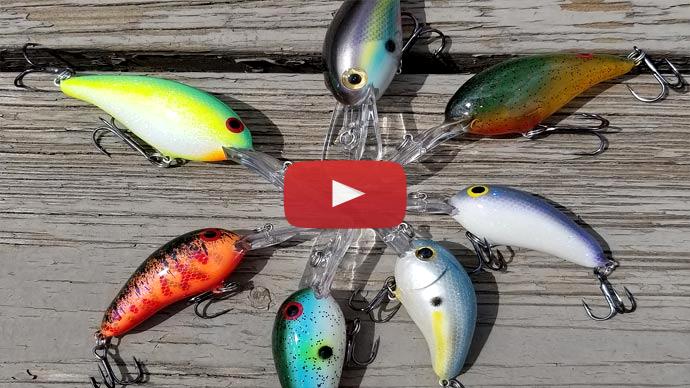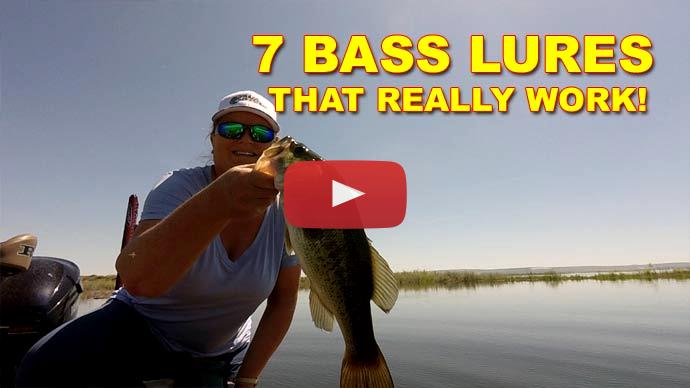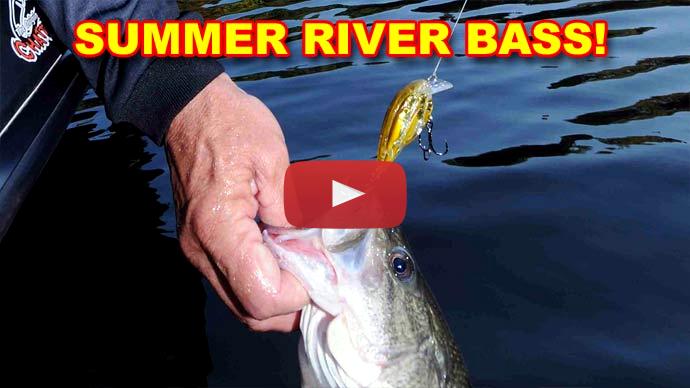Glenn: There you go. Nice. They're in here.
Keri: Come here you. Time to get in the net. Come here baby. Come here. Come here. Ooh, come on Glenn. Come on Glenn. There we go. There we go. He's got a sore on his tongue. There he goes.
Glenn: Hey folks. Glenn May here with BassResource.com and we're here in the dog days of summer. That's, you know, August, September when it gets really hot out, and fishing can be tough. There's a lot of guys out there that struggle during this time of the year, and if you're one of them, you've got a lot of company. Trust me, it can be tough to find them. There's a lot of reasons to that, and I want to get into that. Like how to fish, catch fish during the dog days of summer, that's what we're talking about today.
The thing that happens a lot is in right from spring into summer, that transition, and then, into mid-summer, there's a good population of the bass that will go out deeper and they'll be on those deeper rock piles, those creek channels, those deeper points. And guys that are really good at deep water structure fishing do really well catching fish in that deeper area.
What sometimes happens is you get in the later part of summer, those dog days, and suddenly, the fish seem to have disappeared, you're not catching as much. And the misconception is the hotter it gets, the deeper it's going to drive the fish. So these people will go out and fish deeper and deeper and they're still struggling and can't find fish. So let's talk about what happened there. What's going on?
Well, what can happen is a thermocline can set up. This can happen anywhere. I've seen it. It happens the most down the southern part of the U.S., but I've seen it happen up in lakes in Canada too. If you've got a really good, warm summer, it can set up.
Now, let's talk a little bit about the thermocline, what it is, and why it's so important. Thermocline, what happens during the summertime is the water that is cooler is on the bottom of the lake and the hotter water rises and it stays that way. So the cooler water is down where there's less light penetration or not even any light penetration. So there's no oxygen down there, it starts to deplete and pretty soon, there's no more oxygen, there isn't any more nutrients, it's basically void of any life or activity.
In fact, fish can't live down there. They can go down for short periods of time, but they can't stay down there. It really isn't enough oxygen or anything down there for them to feed on.
You've got conversely this layer on the top. Think of it like a chocolate, you know, cake. You've got this cold layer down below, you've got this warmer layer on top, it's got lot of nutrients, oxygen-rich, relatively speaking, and this is where a lot of the fish are. You've got this little thin layer in the middle which would be like the frosting. This is the thermocline.
This is a transition area between those two layers. It's a denser layer of water that usually collects a lot of debris and, you know, like weed particles and algae and other things in there. So that's a good thing because you can see it if you have a depth finder.
You need to go out on your lake, check your depth finder, turn up the gain and sensitivity. If you see a solid line anywhere between the bottom and the top, that's your thermocline. Okay? It's a dark band, just straight and horizontal. Anything below that, don't fish.
And this is what can happen, is these people have been fishing deeper water in the early and mid-part of summer. Now, those areas are below that thermocline. And they think, okay, I need to keep fishing deeper. See, the thought here is this doesn't work because there isn't any fish. You need to know where that thermocline is and come up above that.
And mind you, you can go one weekend and you won't see the thermocline at all, but it'll set up and the next weekend, it'll be there. Also as the temperatures warm, that thermocline will tend to move up. So it's important to check for it every time you go out in this time of year to see if your lake's got a thermocline on it. You can't go off of what you saw last week.
If a thermocline is set up in your lake, you have three options available to you to keep catching fish. Now, the first thing you want to do is in those areas where you were catching fish before in deeper water, just move up to the shallow areas closer to it, and cover water. You want to fish the areas where the fish will set up shop. So logs, stumps, rocks, docks, weed edges, those type of things.
Grab a spinnerbait, grab a crankbait, and start covering water and fishing anything that's visible. Once you get bit, then slow down and cover that area more thoroughly with like worms and jigs and that sort of thing because the fish have schooled up, they're going to congregate more, the thermocline tends to concentrate fish. So if you catch one fish, there's more around in that area. So don't just keep on going down the bank, you may have just missed the motherload of fish. So slow down and work that area more thoroughly, catch more fish until you don't think you're going to get any more bites, or you've caught all the fish in that area. Then, speed up again, pick up that crankbait or spinnerbait and just keep on going down the bank and cover more water until you connect with another fish, rinse, lather, repeat.
Now, there is an exception to fishing these schooling bass, and that is the big ones. Big ones, the big lunkers, those are the ones like five, six pounds and above, they tend to be loners this time of year. So you can go down this little creek channel, breaking the creek channel and you're fishing rocks and stumps along there and you'll catch a big one. You may have to go another 500 yards down that creek channel or maybe even a mile before you catch another big one. They just tend to be one at a time little loners.
Now, that might not be a bad thing if you want big fish, especially if you're fishing in a tournament. All you need is five big ones. So it can be a little bit tedious, a little bit slower, but you can end up with a really big bag if you want to target big fish. Just, it's not like when you're fishing schooling bass where you slow down, and you fish the area more thoroughly when you get one. In this is instance, if it's a really big one, there's usually not going to be another big one around. So just keep on going and keep fishing that structure where you caught that big one off of and you'll probably catch some more.
That's one option. One of three. The second option out of the three is if you're fishing a lake or reservoir that's river-fed, go up to the shallow part of that lake. Get up there where that river is and fish that current. If you can get in the river, even better. Current does a number of things. It brings in cooler water, it brings in oxygen-rich water, and that current positions the fish behind anything that breaks that current. Be it rocks, logs, wing dams, it could be bridge pilings, what have you. And so, it makes it a little bit easier to find those fish. You've just got to fish those eddies and those breaks where those fish set up in that slack of water area ready to dart out of that current and grab a meal and go back in there. So just bring your lure right down those current breaks. Right on the edge, you'll see that between the transition, between the eddy and the current, there's a current seam. That's where you want to get your lure to drift into because that's where the bass will strike it. So you can fish those areas.
I know a lot of guys have won tournaments that way. A bunch of guys out there fishing deeper structure and deep weed lines and having a hard time catching a limit and these other guys go up in the shallow water areas and just crush them, you know. Get upstream, get up in that current. You can catch a lot of fish that way.
The third option is if your lake has weed beds, grass beds. You know, I'm talking about hydrilla, microalgae, milfoil, coontail. These type of things grow up, they're straight stalks and in the middle of the late summer, they canopy over, and they top out, and they can form this thick canopy. These areas can be really, really productive because the canopy, it has shade underneath, so the water underneath is a little bit cooler, so it holds more oxygen, the weeds themselves produce a lot of oxygen. So the area around that water would have less oxygen than right underneath that canopy. It's an oxygen-rich area. Plus those weeds, they attract and hold a lot of, you know, algae and zoo plankton and, you know, little bugs and insects which attract the bait fish. And wherever you find bait fish, well, that's where you're going to find the bass.
So it's a great little ecosystem in there where the bass can be congregated in there feeding heavily. So there's three ways to attack those canopies of weeds.
One is to go over the top. Let's say a frog or, you know, a top water type lure like a toad, something like that, throw it out over the top of it and just and just reel it in at a steady pace. Make that disturbance, like a rat, you know, bait, something like that. The bass will be able to track that disturbance and they'll blast it, a lot of times right through that canopy without warning. It could be startling, it can scare the bejeebies out of ya. The thing you've got to do is when you see that blow-up, you've got to resist setting the hook right away.
If you're not getting bit that way, you can go to the edges of those weeds and you can fish those with, you can probe the edges and the depths with crankbaits, with spinnerbaits, with worms, with jigs, with soft plastic stick baits. I like to fish soft plastic stick baits myself, they're nice and slow, has enticing fall. The idea here is to get these fish to come out underneath that canopy to attack that lure. And a lot of times, the more active fish are on those edges patrolling around looking for those bait fish. So you can catch a lot of those active fish along there. Crankbaits work really well if you can prevent them from getting snagged in those weeds. Spinnerbaits work really well as well.
If probing the edges doesn't work, then, you've got to go and dig them out. And what I do is I'll take a jig or a plastic creature bait, for example, a Rage Tail. A Rage Bug for example works really well. Any kind of a beaver-style bait, small, compact, four or five-inch bait works really well because you want to get through the canopy. So anything that's got a lot of appendages on it or a big, long tail like a sickle tail worm or something can get hung up in those weeds and it won't get through. And you want to put a heavy weight on it, like a half ounce to an ounce and a half weight bullet sinker. And the idea here is you take it and you throw it up in the air and let it come down and it will punch through that canopy to where those fish are waiting. That's the key.
A lot of times, once it punches through, it gets bit right away. It's just a reaction strike, something suddenly appears right before them, it looks like something that's alive, and boom, you get nailed right away. But if you don't, just let it get down to the bottom and jig it on the bottom and work it like you normally would a plastic bait or a jig, just drag it in or popping it off the bottom.
But those are basically the three different options you have available to you when a thermocline sets up. If you do that, I guarantee you that you are going to catch fish even during the dog days of summer. I hope that helps. For more tips and tricks like this, visit BassResource.com.



